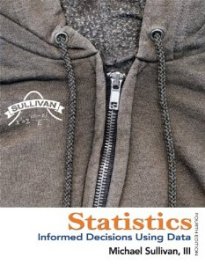Saturday, August 17, 2013
Statistics: Informed Decisions Using Data 4th Edition
Statistics: Informed Decisions Using Data 4th Edition by Michael Sullivan III connects statistical concepts to students’ lives, helping them to think critically, become informed consumers, and make better decisions. Throughout the book, “Putting It Together” features help students visualize the relationships among various statistical concepts. This feature extends to the exercises, providing a consistent vision of the bigger picture of statistics.
This book follows the Guidelines for Assessment and Instruction in Statistics Education (GAISE), as recommended by the American Statistical Association, and emphasizes statistical literacy, use of real data and technology, conceptual understanding, and active learning.
Chapter Review answers are now available at the back of the book. Chapter Tests help students prepare for exams. Technology Answers are now included where they differ from by-hand answers. Expanded content includes a discussion of the differences between observational studies and designed experiments, including the various types of observational studies. Section 1.3 presents random sampling and simple random sampling.
Chapter 2 now contains an increased emphasis on reading and interpreting graphs. Chapter 3 gives a presentation of quartiles that emphasizes conceptually what quartiles represent. Chapter four comprises expanded coverage of correlation versus causation and coverage of Simpson’s Paradox. Chapter 5 now emphasizes using tree diagrams to determine chances and interpretation of a probability. A new Placing It Together part summarizing the assorted methods for computing chances contains two flowcharts to help students select a method for figuring out probabilities.
Chapter 6 emphasizes utilizing possibilities to establish unusual results. Chapter 8 contains extra relevant examples that utilize simulation to exhibit the sampling distribution of the sample mean; a new exercise develops the concept of the mean and standard deviation of the sampling distribution of the pattern mean, and issues foreshadow the idea of a P-value.
Chapter 9 clarifies the interpretation of “degree of confidence,” and features a discussion of bootstrapping, an algorithm for generating bootstrap samples, and methods for estimating the population proportion when the normality condition will not be satisfied. Chapter 10 issues are written in everyday language that results in a speculation take a look at, with an emphasis on using confidence intervals to test hypotheses.
Chapter 11 consists of McNemar’s check for comparing two inhabitant proportions from dependent sampling, asking students to determine on the appropriate test. Chapter 12 workout routines feature extra related and fascinating knowledge units, as well as an emphasis on analyzing conditional distributions to identify the major contributors to the scale of the chi-square test statistic. Chapter 13 affords an up to date discussion of 1-manner analysis of variance that emphasizes the logic behind the procedure.
More details about this book...
or
Download Statistics: Informed Decisions Using Data PDF Ebook :
Subscribe to:
Post Comments (Atom)

 Subscribe to email feed
Subscribe to email feed





